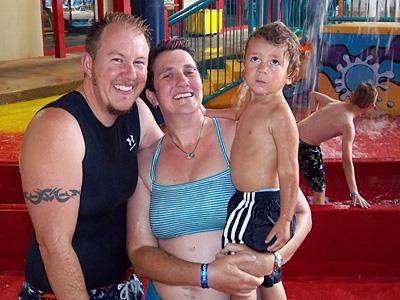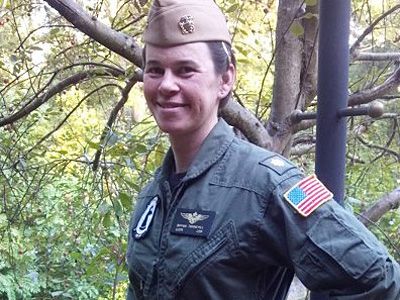 With the anniversary of the repeal of Don’t Ask, Don’t Tell just passed, questions are arising over the military’s continued stance that transgender people are unfit to serve.
With the anniversary of the repeal of Don’t Ask, Don’t Tell just passed, questions are arising over the military’s continued stance that transgender people are unfit to serve.
The Advocate tracked down some current and recent transpeople who are serving or have just finished serving.
In the interest of full disclosure, this author must admit to serving in the US Army during the Vietnam Era (1971-1973). She did not serve oversees , but rather was stationed at the United States Disciplinary Barracks at Fort Leavenworth, KS, where she was a correctional specialist who rose to the pay grade of E5 (Spec-5, which is equivalent to sergeant). She separated with an Honorable Discharge and a Presidential Commendation.
This was all around two decades before she transitioned.
The Advocate’s article features looks at Toni Blessing, who served 8 years as a petty officer in the US Navy from 1996 to 2004 and Brynn Tannehill, a former Navy lieutenant-commander.
 Blessing’s fellow crewmen called him “the ideal sailor”. Blessing’s service record is reported to be above reproach. When Blessing was having his exit interview, his commanding officer asked him for an explanation for why he was getting out.
Blessing’s fellow crewmen called him “the ideal sailor”. Blessing’s service record is reported to be above reproach. When Blessing was having his exit interview, his commanding officer asked him for an explanation for why he was getting out.
I told him I’m transgender, and unfortunately the military sees that as a problem. I need to live my life as who I am, and I can’t be me and be in the Navy.
–Toni Blessing
Gay and lesbian (and bisexual) Americans are now allowed to serve openly in the United States Military. Transgender Americans serve in secret. But make no dobt about it, we do serve.
Andy is a US Army major and a transman who is in the Active Guard Reserves. Because of the current policy, he is forced…
…to work so hard to have to be female, and it would be much easier to be who I am, and be a guy.
Andy goes on:
I think there’s more of a turning of a blind eye. Because people kind of just identify you as a butch lesbian, or just an effeminate man that’s gay. It’s OK to be gay [since DADT was repealed], so it’s easier to blend in.
–Andy
Jennifer, a transwoman and an Army Sergeant serving in the Southeastern part of the country, sees a bit different reality.
I’d like to say that there’ve been more positive [attitudes] toward any aspect of feminine-based personality traits [since DADT repeal]. But when it comes to the military, it’s still very much a hypermasculine, macho-based ideology.
Blessing was out to several fellow sailors and began taking testosterone before his separation. His Navy buddies helped teach him how to shave.
Sharing the transgender secret with anyone in the military is not recommended however. There are resources, such as the Servicemembers Legal Defense Network and Outserve. Outserve currently hosts a secretive group of transgender members, totally over 70, which is about 1% of the Outserve membership.
Most would prefer to be open about who they are.
I would be able to perform my job much better, without holding back anything. There’s no question about running away, or escaping, or trying to find an easy way out. It’s simply wanting to be myself, while continuing to serve and be the best that I can be where I’m at.
–Jennifer
 Brynn Tannehill found a way to continue what she was doing, but it is not for everyone. After separating and before she began working as a defense contractor, she transitioned. Her civilian leadership and the uniformed officers she works with are aware of her trans identity.
Brynn Tannehill found a way to continue what she was doing, but it is not for everyone. After separating and before she began working as a defense contractor, she transitioned. Her civilian leadership and the uniformed officers she works with are aware of her trans identity.
The team that I work with, it’s an open secret that I’m trans. And it hasn’t been an issue for as long as I’ve been here. It hasn’t come up at all, and [even when] the Department of Defense leadership was here, it has not come into play, that I can tell, so far in the six months that I’ve been here.
–Tannehill
Brynn blogs for Outserve and writes for Outserve magazine.
The Department of Defense instructions regarding medical standards list several trans-related procedures as disqualifying acts. Section 6130.03 mentions “history of major abnormalities or defects of the genitalia, such as change of sex [and] hermaphroditism.” The same regulations also reference disqualifying mental health conditions, including “current or history of psychosexual conditions, including but not limited to transsexualism [and] transvestism.” The regulations also forbid service by those with “sexual and gender identity disorders,” as defined in the American Psychiatric Association’s Diagnostic and Statistical Manual.
Previous drafts of the DSM categorized transgender identity as “gender identity disorder,” though that language will be revised in the DSM-V, slated for publication in Spring 2013. The revised manual will refer to transgender identities as “gender dysphoria,” removing the pathologizing language referring to a “disorder.”
Realistically we can expect a long wait before the military catches up with medical understanding. The military considered homosexuality a mental illness until 2009.
Transitioning after separation also has its problems, Upon discharge from the service, one receives a DD-214 form with one’s full name. Accessing veterans benefits requires the form. But getting the name changed on the form has proven to be quite difficult.
There’s a lot of education that needs to be done among the public about what it means to be a transgender American, which SLDN along with our allies are working on. But it’s not something that’s going to happen quickly.
—Zeke Stokes, communications director for the SLDN
Stokes cites the makeup of the Congress in claiming that nothing currently can be done. But this is not in the court of the Congress. That body is not why we cannot serve. We can’t serve because of military regulations, which do not depend upon Congress.
Stokes is correct in the fact that securing rights for transgender servicemembers has not been the call to arms that ending DADT was.
Here’s Leon Panetta, thanking gay and lesbian servicemembers for their service.
Notice that transgender was not mentioned. One can only opine that Panetta does not believe that transpeople deserve the dignity and respect that he mentioned. And that “everyone” does not include us.
Although Panetta said he remains ”committed to removing as many barriers as possible to make America’s military a model of equal opportunity,” there are no plans in the foreseeable future to alter military medical regulations to allow transgender Americans to serve their country openly.
Transgender Americans in the Armed Forces continue to be discriminated against and discharged just for being who they are based on an antiquated medical regulatory ban. After being discharged, many transgender veterans encounter issues accessing benefits due to restrictions around changing identification forms. OutServe, an organization serving as a resource for LGBT servicemembers, counts more than 6000 actively serving military personnel who identify as transgender, but must hide their identity every day.
–GLAAD

3 comments
Author
…but the Feds tracked me down and gave me the choice of service or the OK State Pen. I figured I had a better chance on the outside.
Besides I had a family, with a child to raise.
For many people the military is the only way out of certain life situations–many people have done been able to get a start in life through serving and for others it has been a disaster. I’m deeply disappointed that the military always is the highest rated public institution in the country–it is overwhelmingly popular because, as Chris Hedges wrote, “war is a force that gives us meaning” because we are a warlike people.
But the practical matter is that trans people need a leg up and an opportunity to have a job, to get training and if that the only way left then they should have that right and one hopes they don’t get chopped to pieces in the process.
Nice post.